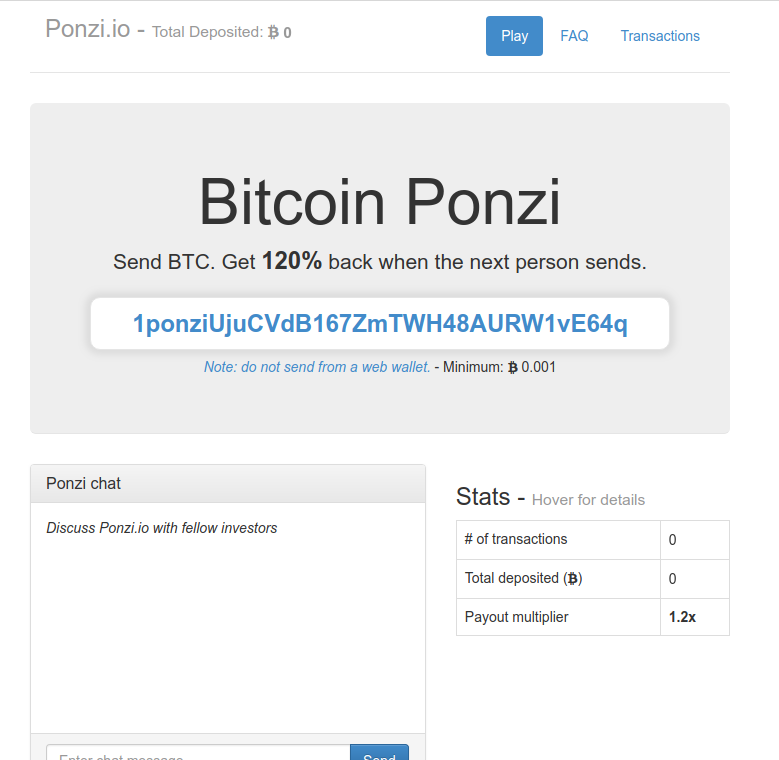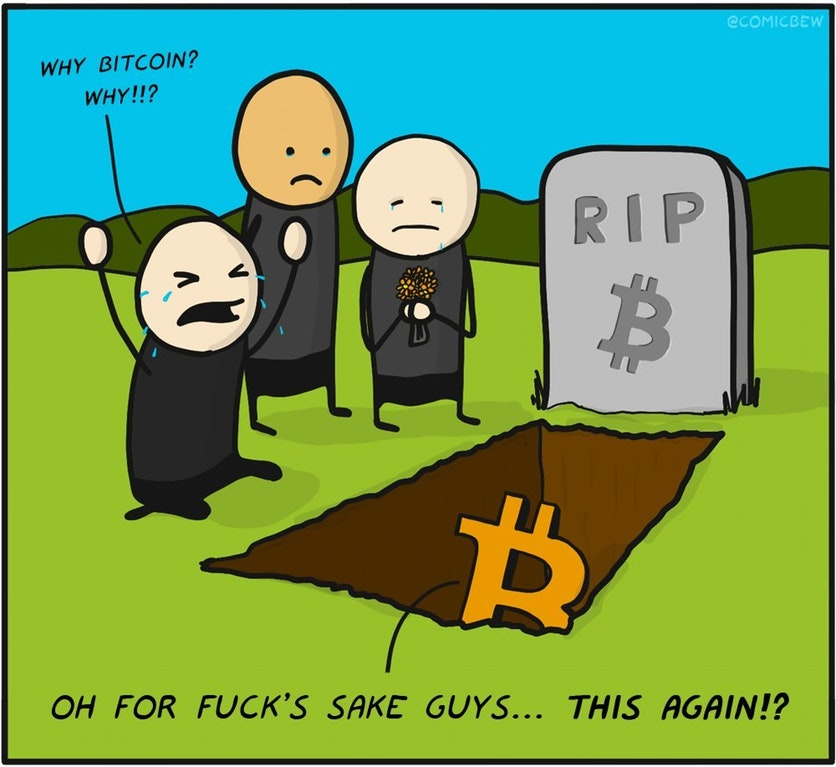It was January 2014. Bitcoin had just suffered a material crash from the USD1,300 high to a low of around USD900. There were no major commercial applications for bitcoin and the most popular network applications were gambling sites such as Satoshidice which spammed the bitcoin network. Therefore, the strange appearance of Ponzi.io was quite interesting.
Ponzi.io defined itself as a social experiment. The website offered a new version of the known Ponzi scheme; you sent a set amount of bitcoin and received 120% of your investment. This was a no-brainer scam: it only works if people keep investing in the scam, and it is known. The public blockchain address still receives payments once in a while, and currently holds a positive balance. However, since 2014 it has no active withdraws. The idea is simple: you need to find the next sucker in line to invest, and as long as many people invest, then the payouts are ensured.

The math behind ponzi.io is simple: as long as people keep investing, there will be sufficient funds to pay out the next guy in queue. As long as there's a steady growth in the user base, the scam can go on. Ponzi.io ran for several days, just for the fun of it, and without any of the original maintainers actually making money off it. Around the end of February 2014 the team published that "the experiment is over", while they did not share any information or results from the experiment.
This Ponzi scam was based on the original Ponzi scam; which, is one of the most common investor frauds. It is a simple "pay it forward" scam, where each investor is promised a guaranteed interest for his funds (usually at a slightly above-market rate) for his investment, and the investment mechanism is not transparent. The original scam involved approaching investors to gain from a known weakness in arbitrage of postal stamps ( see the Wikipedia entry ).
Ponzi found a real weakness in the postage system, where an international rely coupon, a token for stamps, was valued differently in different states. According to Ponzi's calculations, he could quadruple his investment on each round just by buying one in Italy and selling them in the United States. Therefore, he approached potential investors to secure the funds to scale up his operation. The problem was, that while he had a large number of investors, his idea didn't scale well. While investors came running in, the costs of both procuring the coupons and redeeming them in the United States was too heavy, and he had sufficient growth to pay out the early investors from the later ones.
The Ponzi scam finally collapsed when the public found out that there is no possibility that such many coupons were bought and sold, and that Ponzi itself was, basically, moneyless.
This caused a bank run where some investors paid, but most investors received 30% of their investment back, and some banks collapsed as a result of his scam.
A pyramid scheme is a more sophisticated case of a Ponzi, where each investor needs to bring a downstream recipient in order to receive his compensation, but basically, it is the same.
While Chales Ponzi's company was called the Securities Exchange Company, there was no Securities and Exchange Commission during those days (it was set up during the 1930s). The reason for setting up the investor protection laws in the United States and other countries was to protect investors. Prior to those laws, and even afterwards, there is a large different in the information the investor and the investment managers hold.
The gap could be easily explained by the following case from real life which prohibits insider trading. Around the autumn of 2017, a security breach in the credit scoring company Equifax was discovered. This, of course, caused the company's shares to drop. If you held Equifax shares, you had no way of knowing about this hack before it was published, but had you had this information, you might have sold your shares before others knew about it. This is exactly what some executives were suspected and cleared from doing. Now, if you have more information than others, you can conduct your business in other ways than expected.
So the first reason we need investor protection laws is to protect investors from the managers of the companies they invest in. That's why investment is based on two principles: disclosure and prevention of conflicts of interest. The disclosure section requires that all disclosures be timely and that they shall contain all the relevant information which may allow the investor to opt-in or out of his investment.
For example, if one company (say, PayPal) has an agreement with another company (say, eBay) that it shall be the preferred payment method, and that agreement is terminated, then notification about such as this might cause the paypal stock to drop. The drop in the share is because some people, now, believe that the termination of the deal will make their investment less profitable, and they seek alternative investments. That's why they sell the PayPal stock. in such case, the price in the stock markets reflects the information provided.
It's not just that stocks go down; stocks may also go up following an important announcement; therefore, the people who know about this information may buy stocks prior to the announcement and sell them promptly thereafter, making a nice profit.
Another kind of investor scam is a pump and dump. A PnD scam is where a change in the price of a specific security is caused without any material information (or, without actual correlation to that information). A person who has no information, finds a specific security and buys it, therefore, increasing its price in the exchanges. When the price is high, he pumps others to buy the security, either by providing them with false information, or by being the broker. Then, he sells his securities at a material profit, before the public understands that there we nothing behind the increase in the security's price.
A pump-and-dump scheme is quite easy to maintain where there is little disclosure obligations. Some dumpers use spam or other messages who pretend to have insider information, which causes a bloom in request for the security. This might be in the form of creating artificial demand, or by publishing fake-news. When a dumper wishes to promote a specific security, he can locate the relevant suckers and profile them via social networks; where he attempts to manipulate them and persuade that he has pertinent information which might cause them to increase.
To put it in simple words, the investment fraud market has been a breeding ground for quick money ever since the securities mechanisms were set up. Therefore, it is quite understood why security protection laws and principles have been set up. These laws and principles came to protect the small-time investors. It is assumed that more wealthy, professional, investors, do not need a legal protection. In the following chapter we'll discuss who are the investor types, and what is the difference between them, we'll discuss how to address different investor types and what is and what isn't solicitation.
I'm Jonathan Klinger, I'm a master of law, certified to practice in Israel. I've explored the blockchain, and now I'll be helping you in deciding on whether you should raise funds via a token generating event. I highly recommend you avoid it. Read my Blog for more info.
Previous Chapters:
Preface
Chapter One: Other People's Money, an Introduction.

@jonklinger My opinion of the BTC drop.

Downvoting a post can decrease pending rewards and make it less visible. Common reasons:
Submit
Upvoted ☝ Have a great day!
Downvoting a post can decrease pending rewards and make it less visible. Common reasons:
Submit
Wow. This is a lot of great information. Thank you so much. I am following you too.
Downvoting a post can decrease pending rewards and make it less visible. Common reasons:
Submit
You are more than right with many things, but not with avoiding all tokens generating events. This event is a sure thing: https://steemit.com/ico/@cryptoclick/eroiy-coin-major-pre-ico-opportunity
😊
Downvoting a post can decrease pending rewards and make it less visible. Common reasons:
Submit